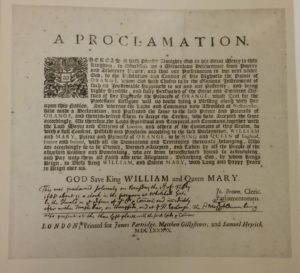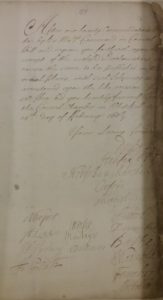What is the difference between printing and publishing? This is perhaps something many of us don’t think about, but there is a difference. After all, we now speak of things being published on the internet, so there is not an inherent relationship between print and publication, at least not anymore. Two documents from the Thomas G. and Louise Rowe Pullen collection perfectly illustrate how important news was published in the past, and they do so with reference to the process by which our own William and Mary went from being Prince and Princess of Orange to King and Queen.
 Thomas G. and Louise Rowe Pullen Collection, MS 65 P96, Box I, Folder 3
Thomas G. and Louise Rowe Pullen Collection, MS 65 P96, Box I, Folder 3
In November of 1688, William, Prince of Orange, landed an army in England to confront his father-in-law and uncle, James II of England, VII of Scotland. The Catholic James had become deeply unpopular, and many thought he was a danger both to Parliament and to Protestantism. James fled the country, and debates began about what should happen. Should he be succeeded by his daughter, Mary, or by her husband? In the end, the Convention Parliament that had been called to resolve the crisis offered the crown jointly to William and Mary, making them the only joint monarchs in English history.
![Thomas G. and Louise Rowe Pullen Collection, MS 65 P96, Box I, Folder 3 [detail]](https://libraries.wm.edu/sites/default/files/images/scrc-archive/2017/05/proc2-300x84.jpg) Thomas G. and Louise Rowe Pullen Collection, MS 65 P96, Box I, Folder 3 [detail]
Thomas G. and Louise Rowe Pullen Collection, MS 65 P96, Box I, Folder 3 [detail]These documents show how that decision became public knowledge. On one hand we have the printed declaration, explaining how and why the decision has been taken, and proclaiming William and Mary King and Queen of England, France and Ireland. Yet that document has been altered by someone writing on it, which tells us that all of this was publicly proclaimed before the printed text was posted:
“This was proclaimed solemnly on Wensday the 13th of Febry 1688 about 11 a clock in the forenoon at Whitehall Gate by the Herald in the presence of the Lds & Commons, and immediately after within Temple bar, in Cheapside, and at the R. Exchange. The Ld Mayr Recorder & Aldermen being also present at the three last places with the said Lords & Commons”
These were all public places – the Palace of Whitehall in the City of Westminster, and several locations in the City of London – a ceremonial gate, a major market, and the stock exchange. So the first news was published vocally, and in the presence of a lot of important men.
 Thomas G. and Louise Rowe Pullen Collection, MS 65 P96, Box I, Folder 3
Thomas G. and Louise Rowe Pullen Collection, MS 65 P96, Box I, Folder 3
The next stage was the publication of the printed text. A document from the same collection, signed by the members of the Privy Council, is the order to post printed proclamations like the one discussed above. The document was to be “published in the usual places” so that it could be read as well as heard, and everyone should then know that William and Mary were now the King and Queen.